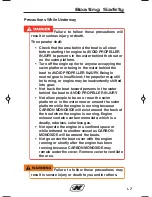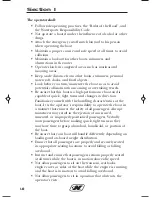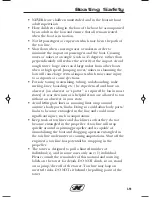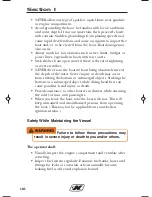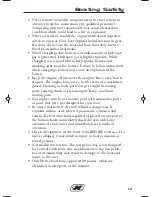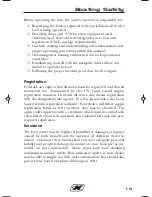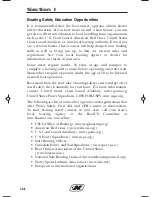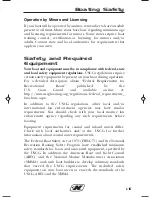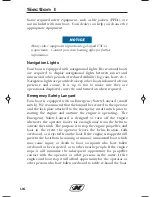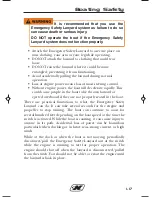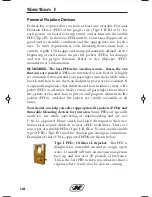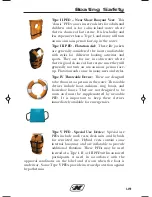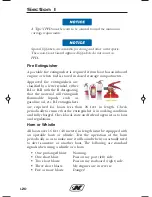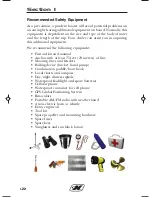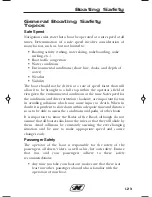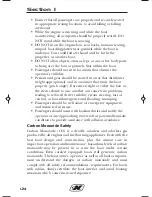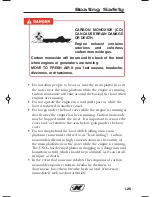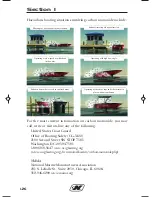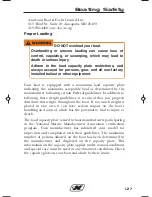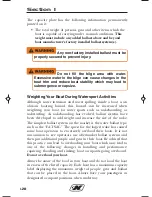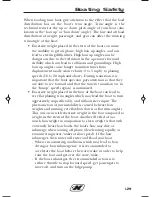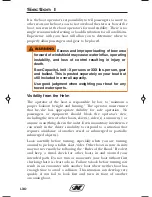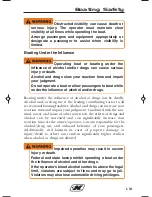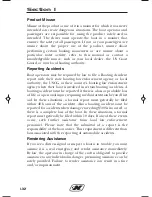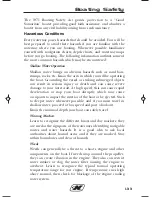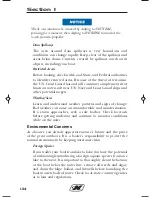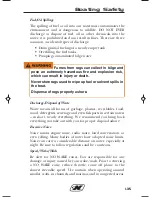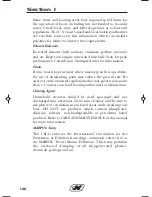
1-21
Boating Safety
Bilge Pump(s)
Bilge pump(s) are installed in your boat to remove water that may
accumulate in the bilge. Know the location of the pump(s), where
they discharge, and where switches are located. Typically there are
manual switch and/or an automatic switch position(s). Periodically
test the operation of bilge pumps by activating the manual switch
and observing the water discharge. It is best to leave the bilge pump
switches in automatic mode, so as to not allow excess water to
unknowingly accumulate in the bilge of your boat. If your bilge
pump comes on too frequently or continuously, investigate the
source of leaking water (check for hull damage, hose or piping
leaks, missing drain plug, exhaust system or ballast system failures,
etc.), and/or return to shore. Excess water in the bilge of your boat
can cause loss of engine power, sinking, and/or capsizing.
Visual Distress Signals
All vessels used on coastal waters, the Great Lakes, territorial seas,
and those waters connected directly to them up to a point where a
body of water is greater than two miles wide, must be equipped with
USCG approved visual distress signals. Your dealer or local
authorities can help you select appropriate visual distress signals for
your area.
If you are required to carry distress signals, you must have three
USCG approved pyrotechnic devices. Be sure they are in
serviceable condition, not exceeding the expiration date and
stored in a cool, dry location in a red or orange waterproof
container.
Pyrotechnic signaling devices can cause
fire and/or explosion, death, serious injury, and property
damage if improperly handled. Follow the pyrotechnic
manufacturer’s directions.
Super_Air_Sec 1.qxp_Nautique Ski Sec 1.qxd 7/17/17 3:20 PM Page 1-21
Summary of Contents for super air 210 2018
Page 2: ......
Page 50: ...1 38 GS20 Safety Labels 1 2 3 4 5 4 4 6 7 6 8 9 12 13 14 15 16 8 9 CORC0674 10 11 Section 1...
Page 52: ...1 40 GS22 Safety Labels 1 2 3 4 5 4 4 6 7 6 8 9 12 13 14 15 16 8 9 CORC0701 10 11 Section 1...
Page 54: ...1 42 GS24 Safety Labels 1 2 3 4 5 4 4 6 7 6 8 9 12 13 14 15 16 8 9 CORC0701 10 11 Section 1...
Page 56: ...1 44 210 230 Safety Labels 1 2 3 5 6 7 8 9 10 11 12 4 4 4 4 5 13 14 CORC0625 Section 1...
Page 58: ...1 46 G21 Safety Labels 1 2 3 5 6 7 8 9 10 11 12 4 4 4 4 5 13 14 CORC0626 Section 1...
Page 60: ...1 48 G23 G25 Safety Labels 1 2 3 5 6 7 8 9 10 11 12 4 4 4 4 5 13 14 CORC0627 Section 1...
Page 109: ...2 5 NOTES GS20 GS22 GS24 G21 G23 G25 210 and 230...
Page 128: ...2 24 Section 2 210 Seating Area Designated Occupant Positions 12 CORC0612...
Page 132: ...2 28 Section 2 230 Seating Area Designated Occupant Positions 15 CORC0613...
Page 134: ...2 30 Section 2 G23 Seating Area Designated Occupant Positions 16 CORC0615...
Page 139: ...3 3 Controls and Indicators CORC143...
Page 166: ...3 30 Section 3 230 G21 G23 and G25 A CORC0505 T HANDLE T HANDLE A CORC0450...
Page 184: ...3 48 NOTES Section 3...
Page 188: ...4 4 Fuel System G21 G23 G25 Section 4...
Page 197: ...4 13 Boat Systems Port and Starboard Ballast Bags G21 G23 G25...
Page 204: ...4 20 NOTES Section 4...
Page 228: ...6 8 Section 6 NOTES...
Page 252: ...8 4 Section 8 NOTES...
Page 274: ...W 8 NOTES...
Page 275: ......
Page 276: ......

